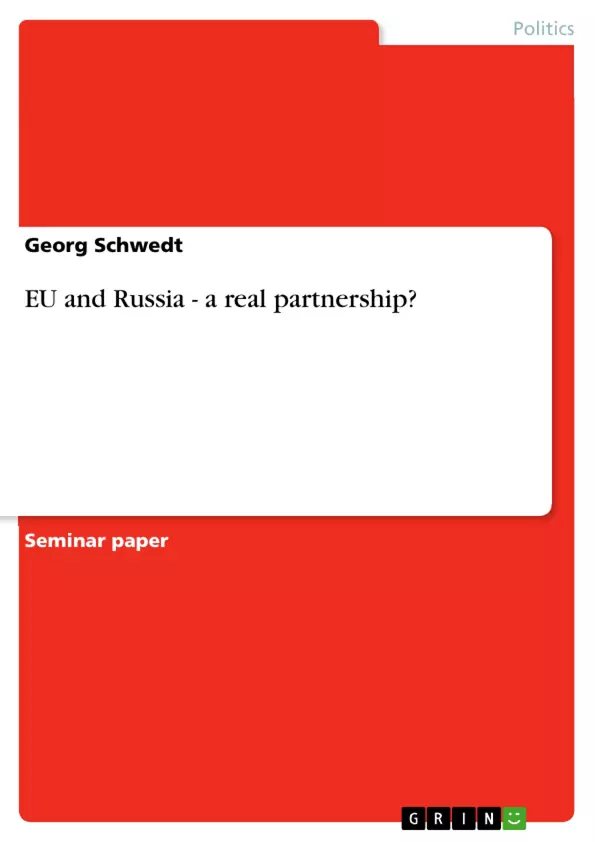Russia is the biggest country in Europe, as well in population as in area. Therefore it is impossible for the other big entity, as well in population as in area, the EU, to ignore Russia. Even more because through the enlargement both now have a common border.
Not only for this reason, but also stemming from economic interest in the big market and its resources, the EU developed multi-faced “partnership” with Russia.
How did these partnership develop? How is it shaped? These are the first two questions this essay deals with. The Kaliningrad policy and the Energy Dialogue thereby serve as actual policy examples.
But are the EU and Russia following common interests as the term “partnership” indicates? What is missing, what are their concepts and what are the future prospects? These are the questions answered in the second part.
Inhaltsverzeichnis (Table of Contents)
- Introduction
- History of the EU-Russia relations
- The Gorbatshev Years
- The Yeltsin Years
- The Putin Years
- The instruments of the EU-Russia relations
- Agreements
- The Partnership and Co-operation Agreement (PCA)
- The EU Common Strategy on Russia
- Technical and financial assistance programmes
- Sectoral Agreements
- Meetings and bodies
- Summits
- The Permanent Partnership Council
- Co-operation Committees and other bodies
- Policy Examples
- Kaliningrad
- The Energy Dialogue
- Agreements
- The interests of the EU and Russia
- Common interests
- Economic
- Security
- Political
- Divergent interests
- Economic
- Security
- Political
- Common interests
- What is the overall concept of interests?
Zielsetzung und Themenschwerpunkte (Objectives and Key Themes)
This essay aims to explore the development of the EU-Russia partnership, analyze its key features, and evaluate the common and divergent interests of both parties. It examines the historical trajectory of the relationship, focusing on the presidencies of Gorbatshev, Yeltsin, and Putin. The essay also analyzes the instruments and policy examples that shape the partnership, specifically the Kaliningrad policy and the Energy Dialogue.
- The historical evolution of the EU-Russia partnership
- The instruments and mechanisms governing the EU-Russia relationship
- The common and divergent interests of the EU and Russia
- The significance of the Kaliningrad policy and the Energy Dialogue
- The future prospects and challenges of the EU-Russia partnership
Zusammenfassung der Kapitel (Chapter Summaries)
- Introduction: This chapter introduces the essay's central questions, emphasizing the importance of the EU-Russia relationship and its evolution. It highlights the significance of the Kaliningrad policy and the Energy Dialogue as case studies.
- History of the EU-Russia relations: This chapter traces the history of the EU-Russia relationship from the Gorbatshev years through the Yeltsin years, focusing on key developments, agreements, and challenges. It analyzes the impact of political and economic changes on the partnership.
- The instruments of the EU-Russia relations: This chapter delves into the legal and institutional framework that governs the EU-Russia partnership. It examines agreements, meetings, bodies, and specific policy examples, such as the Kaliningrad policy and the Energy Dialogue.
- The interests of the EU and Russia: This chapter explores the shared and divergent interests of the EU and Russia, focusing on economic, security, and political considerations. It examines the tensions and challenges arising from these differing interests.
- What is the overall concept of interests?: This chapter offers a comprehensive analysis of the overall concept of interests in the EU-Russia relationship. It explores the underlying motivations and strategic considerations that shape the partnership.
Schlüsselwörter (Keywords)
The key terms and concepts explored in this essay include EU-Russia relations, partnership, common interests, divergent interests, historical evolution, instruments of cooperation, Kaliningrad policy, Energy Dialogue, strategic considerations, and future prospects. The essay examines these themes through an analysis of the historical trajectory, the legal framework, and the political and economic dynamics of the EU-Russia relationship.
- Arbeit zitieren
- Georg Schwedt (Autor:in), 2004, EU and Russia - a real partnership?, München, GRIN Verlag, https://www.grin.com/document/54533



